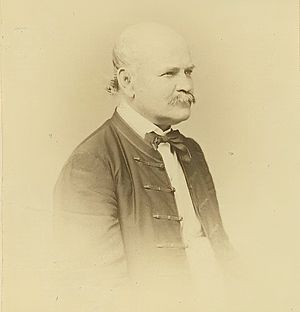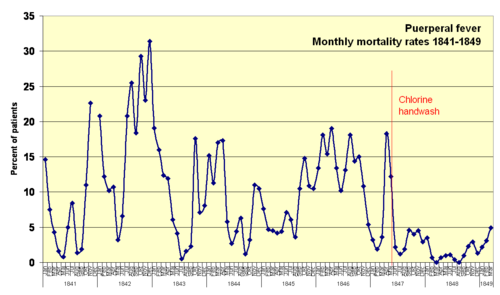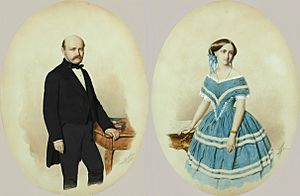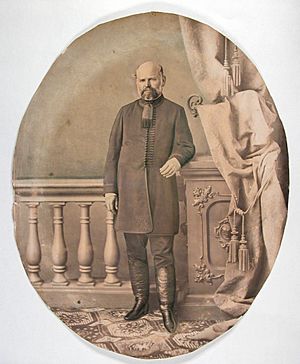Ignaz Semmelweis facts for kids
Quick facts for kids
Ignaz Semmelweis
|
|
|---|---|

Dr. Ignaz Semmelweis, aged 42 in 1860, photograph by Borsos és Doctor
|
|
| Born |
Semmelweis Ignác Fülöp
1 July 1818 |
| Died | 13 August 1865 (aged 47) Oberdöbling, Austrian Empire (now Vienna, Austria)
|
| Citizenship | Kingdom of Hungary |
| Alma mater | University of Vienna |
| Known for | Introducing hand disinfection standards, in obstetrical clinics, from 1847 |
| Scientific career | |
| Fields | Obstetrics, surgeries |
| Spouse(s) |
Mária Weidenhofer
(m. 1857) |
| Children | 5 |
Ignaz Philipp Semmelweis was a Hungarian doctor and scientist. He is known as the "saviour of mothers" because he found a simple way to stop a deadly disease called "childbed fever." This disease was very common and often fatal in hospitals during the mid-1800s.
In 1847, while working at a hospital in Vienna, Semmelweis noticed something important. Doctors' wards had many more deaths from childbed fever than midwives' wards. He figured out that washing hands with a special chlorine solution could greatly reduce the number of deaths.
Even though his idea saved many lives, most doctors at the time did not accept it. They didn't understand why handwashing worked and some felt insulted by the suggestion. Semmelweis faced a lot of resistance. His ideas only became widely accepted years after his death, when Louis Pasteur proved the germ theory of disease. This theory explained that tiny germs cause sickness, which supported Semmelweis's findings.
Contents
Ignaz Semmelweis: His Early Life
Ignaz Semmelweis was born on July 1, 1818, in Buda, which was part of the Austrian Empire. He was the fifth of ten children in a well-off family. His father, József Semmelweis, was a successful grocer.
His family had German roots. His father opened a large business selling spices and other goods. By 1810, he was quite wealthy. Ignaz first started studying law at the University of Vienna in 1837. However, the next year, he changed his mind and began studying medicine instead.
He earned his medical degree in 1844. After that, he decided to focus on obstetrics, which is the field of helping women during childbirth.
A Big Problem in Hospitals
Semmelweis started working as an assistant doctor in the First Obstetrical Clinic at the Vienna General Hospital in 1846. His job included checking patients, helping with difficult births, and teaching students.
There were two maternity clinics at the hospital. The First Clinic had a very high death rate from childbed fever, about 10% of mothers died. The Second Clinic had a much lower rate, less than 4%. People knew about this difference. Women would often beg to be sent to the Second Clinic because they were afraid of the First.
Some women even chose to give birth in the streets. They would pretend to have given birth on their way to the hospital. This way, they could still get childcare benefits without going into the dangerous First Clinic. Semmelweis was very confused why childbed fever was rare for these "street births." He wondered what protected these women.
His Amazing Discovery
Semmelweis thought hard about why so many mothers were dying in the First Clinic. He noticed that doctors and students often went straight from examining dead bodies in the autopsy room to helping women give birth. Midwives, however, did not do autopsies.
He realized that something from the dead bodies was being carried on the doctors' hands to the mothers. This "something" was causing the deadly childbed fever. He called it "cadaverous particles" (tiny bits from dead bodies).
In May 1847, Semmelweis made a rule: all doctors and medical students had to wash their hands. They had to use a special chlorine solution before examining any pregnant women. This solution was very strong and helped remove the invisible particles.
The results were incredible! The death rate from childbed fever in the First Clinic dropped dramatically. It went from about 10% to less than 1%. This showed that his idea worked. He also made sure all instruments used during birth were cleaned with the chlorine solution.
Why People Didn't Believe Him
Even with such clear results, many doctors did not accept Semmelweis's ideas. At that time, people believed diseases were caused by imbalances in the body. They didn't know about germs. Doctors also felt insulted by the idea that their hands could be dirty and cause sickness. They were seen as gentlemen, and handwashing seemed beneath them.
Semmelweis couldn't explain *why* handwashing worked, only that it did. This made it harder for others to believe him. His observations went against what most medical experts thought was true.
Because of this, his ideas were often ignored or even made fun of. He was even fired from the hospital for political reasons and faced a lot of trouble from the medical community in Vienna. He was eventually forced to move to Budapest.
His Later Life and Legacy
After leaving Vienna, Semmelweis became the head doctor of the obstetric ward at a small hospital in Pest in 1851. Childbed fever was also a big problem there. After he took over, he almost completely got rid of the disease. From 1851 to 1855, only 8 out of 933 mothers died (less than 1%).
Despite these amazing results, other doctors in Budapest still didn't fully accept his methods. In 1855, he became a professor at the University of Pest. He made sure handwashing was used there, and again, the death rates dropped.
In 1857, Semmelweis married Mária Weidenhofer. She was 19 years younger than him, and they had five children together.
Semmelweis wrote a book about his findings in 1861. However, it received bad reviews from doctors in other countries. He became very angry and wrote strong letters to other doctors, calling them irresponsible. His friends and even his wife thought he was losing his mind.
In 1865, Semmelweis was taken to a mental hospital in Vienna. He died there 14 days later, at the age of 47, from an infection.
It was only many years after his death that his work was truly understood and accepted. This happened when Louis Pasteur developed the germ theory of disease. Pasteur's work explained that tiny, invisible germs cause infections. This gave a scientific reason for why Semmelweis's handwashing method worked so well.
Today, Ignaz Semmelweis is seen as a hero and a pioneer of antiseptic procedures. His story teaches us how important it is to keep an open mind to new ideas, even if they challenge what we already believe.
Many things honor his memory:
- Semmelweis University, a medical university in Budapest, Hungary, is named after him.
- The Semmelweis Museum of Medical History is in the house where he was born.
- There are hospitals named after him in Vienna and Hungary.
- In 2008, Austria made a special commemorative coin with his picture.
- A small planet, 4170 Semmelweis, is named after him.
- He was featured in a Google Doodle in 2020 to promote handwashing during the COVID-19 pandemic.
- The Ignác Semmelweis Prize is Hungary's most important medical award.
Films About Semmelweis
- That Mothers Might Live (1938), a US film that won an Oscar for best short film.
- Semmelweis (1940), a Hungarian film.
- Semmelweis – Retter der Mütter (1950), an East German film.
- Ignaz Semmelweis: Gynecologist (1989), a film from West Germany, Austria, and Hungary.
- Semmelweis (1994), a Dutch film.
- Docteur Semmelweis (1995), a French and Polish film.
- Semmelweis (2001), a short film from the US and Austria.
Books About Semmelweis
- Louis-Ferdinand Céline wrote a book about Semmelweis in 1924.
- William Forstchen's The Lost Regiment series features a doctor who studied under Semmelweis.
- Morton Thompson's 1949 novel The Cry and the Covenant is based on Semmelweis's life.
- Kurt Vonnegut praised Semmelweis in his 2005 book, A Man Without a Country, calling him "my hero."
Plays About Semmelweis
- An Enemy of the People by Henrik Ibsen is a play where the main character, a doctor, is partly inspired by Semmelweis's struggles.
- Semmelweis, an opera-theater work that premiered in Hungary in 2018.
- "Semmelweis" by Howard Sackler, a play performed in the US in the late 1970s.
- "Dr Semmelweis" a new play by Stephen Brown with Mark Rylance, which opened in 2022.
Images for kids
-
Streptococcus pyogenes are bacteria that cause many cases of severe childbed fever.
-
2008 Austrian commemorative coin picturing Semmelweis (€50 gold coin)
See Also
 In Spanish: Ignaz Semmelweis para niños
In Spanish: Ignaz Semmelweis para niños
- Medical hygiene
- Semmelweis effect












